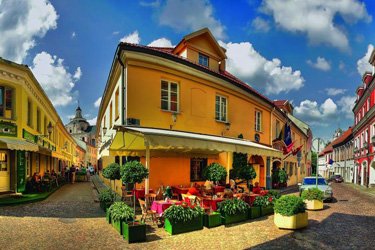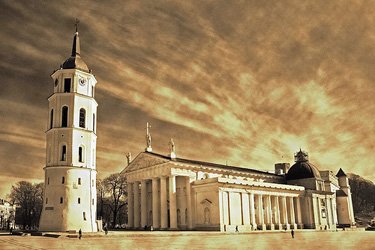Online Check-In
Thank you so much for your online checkin operation: it will speed up the access to your accommodation.
Please, fill in the following form. Entering your reservation ID (check it on your voucher) will make the lookup process easier
Thank you so much for your online checkin operation: it will speed up the access to your accommodation.
Please, fill in the following form. Entering your reservation ID (check it on your voucher) will make the lookup process easier
With one of the best preserved historic centers in Europe, Vilnius can be considered one of the most beautiful cities of art in Europe. Unfortunately, still few include the Lithuanian capital among the unmissable destinations and it's a real shame. The Old Town, almost entirely pedestrianized, protected as a UNESCO World Heritage Site, winds between the Cathedral Square and the Town Hall Square, the Jewish Quarter and the "Independent Republic" of Uzupis.
To admire the small but perfect city center at a glance, climb up to the Hill of Three Crosses or the Gedeminas Tower, two symbols of national history to which Lithuanians are very attached. An undefined number of churches and religious places of every cult follow one another in Vilnius: the ones not to be missed are the Cathedral, the Church of Sant'Anna and the Synagogue in the Ghetto. On this page we recommend the 10 things to see during a holiday or a weekend in Vilnius
About 80 districts, 70 narrow streets and 1487 buildings concentrated in just over 3 square km make the Old Town of Vilnius (Senamiestis) one of the most beautiful historic centers in Europe. Something that has not escaped the UNESCO inspectors who have included the center of the Lithuanian capital among the World Heritage sites. Gothic, Baroque, Renaissance and Neoclassical architecture coexist without architectural horrors, in a succession of palaces, small squares, churches of all kinds.

The heart of the Old Town are two squares: the Cathedral Square and the Town Hall Square, both in the neoclassical style. The whole historic center is a succession of enchanting views but it is the Via Pilies which has led to the Vilnius Castle since 1530 that offers the most beautiful ones. If once upon a time the procession following the King going to the Castle crossed it, the nobles built palaces there and the professors lived there, today it is crowded by tourists looking for souvenirs or some restaurant with outdoor tables. The Jewish Quarter and Uzupis Quarter are also part of the Old Town
Accustomed to the beauty of Italian churches, the Vilnius Cathedral goes almost unnoticed. However, it is worth a visit especially for its historical importance. Built where a sacred fire temple dedicated to the thunder god Perkunas once stood, it is believed to have been the first place of worship consecrated to Catholicism and hence the point from which the Christianization of Lithuania began.
The cathedral, dedicated to Saints Stanislao and Ladislao, was built between 1779 and 1793 in an austere neoclassical style, with a 6-column portico with a pediment on which the scene of the sacrifice of Noah returning from the flood is represented. The interior is simple, with three naves with cross vaults and the beautiful Baroque chapel dedicated to San Casimiro. The bell tower detached from the Cathedral is very unique. Between the Cathedral and the Bell Tower there is the Stebuklas (miracle), a stone which, according to legend, grants wishes if you turn it around 3 times…

Opening hours and ticket price for Vilnius Cathedral
Opening hours: Daily 7am-6pm, Sundays closes at 7pm. Tourist visits are not permitted during church services.
Ticket price: free admission
How to get there: the cathedral is located in Šventaragio g., in the centre, and can be reached on foot.
Take the funicular and then climb on foot to Gedimino's Tower, what remains of the centuries-old Vilnius Castle.
As much as historians have dug into the history of the Lithuanian capital, they have always found a reference to this place in Vilnius.
The castle, built in the 9th century, has served as the residence of the Grand Duke of Lithuania since 1323 but, above all, as a fundamental building in the city's defense system.
Destroyed by fire in 1400, what remains will be devastated until almost nothing remains.

The Tower of Gediminio that you can see now is a reconstruction that took place in 1960 and is home to a museum. Of great symbolic importance for all Lithuanians is the national flag hoisted on the roof of the tower.
Over the centuries, first the Poles, then the Nazis and then the Russians tore it away but the Lithuanians have always raised their banner again. From the top of the tower you can admire a wonderful panorama of Vilnius and the surrounding area.
Opening hours and ticket price for Gediminas Tower and Vilnius Castle
Opening hours: the castle museum is open daily 10-20
Ticket price: adults €6, seniors and students €3, family ticket 2 adults and 4 children €15. Historic Triangle combined ticket (New Arsenal, Old Arsenal and Gediminas Castle Tower) €10.
How to get there: The museum is located in Arsenalo g., 5. It can be reached by funicular from the centre, return €2.
Like Cristhiania in Copenhagen and (once) Montmartre in Paris, Uzupis is a separate “Republic”, a city within a city.
Here mainly artists and intellectuals live and festivals, exhibitions, cultural meetings, concerts, performances and exhibitions of all kinds are constantly organised.
Uzupis is the most fashionable and expensive district of Vilnius but until a few years ago it was the most infamous and dangerous place in the Lithuanian capital.
It was precisely the low prices of the houses (no one wanted them) that attracted penniless artists looking for accommodation.
Since then it has become a separate space and even enjoys its own Constitution with relative President and a currency.
The Constitution, which you can see posted at the beginning of Via Paupio, contains extraordinary "banalities" that could be an inspiration for many constitutions of other states.

The name Užupis means "place near the river" and, in fact, the neighborhood overlooks Vilnia.
It is therefore not surprising, with one of the two symbolic characters of Uzupis being a bronze mermaid created by the sculptor Romas Vilčiauskas. If you want to see it, you have to walk along the river bank and look for the niche in which it is housed.
Always the same sculptor is the author of the statue of the Archangel Gabriel playing the trumpet (angel of Uzupis) which is located in the main square of the neighborhood.